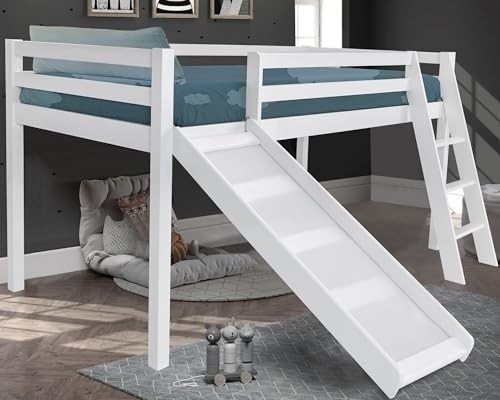Three Reasons To Identify Why Your Bunk Bed Isn't Working (And The Best Ways To Fix It)
A Comprehensive Guide to Children's Bunk Beds: Styles, Benefits, and Safety Considerations
Bunk beds have actually ended up being a popular choice for families looking to maximize space and offer a fun sleeping environment for kids. With their distinct design, they use an innovative and practical option for shared bed rooms, playrooms, or even guest accommodation. This short article checks out the different styles of kids's bunk beds, their advantages, safety considerations, and responds to some frequently asked concerns.
The Allure of Bunk Beds
Children's bunk beds are more than just space-saving structures; they are likewise an entrance to daring dreams and imaginative play. Below is Bunk Beds Children's dalianotte.top of their numerous benefits.
Advantages of Bunk Beds
- Space-Saving: Bunk beds efficiently make use of vertical space, making them an ideal choice for smaller spaces.
- Lively Design: Many bunk bed styles consist of slides, tents, and themed components, stimulating creativity and excitement.
- Partner Sharing: Bunk beds are perfect for brother or sisters sharing a room or accommodating slumber parties.
- Flexible Use: Some designs can be separated into 2 individual beds, using versatility as kids grow.
- Storage Options: Many bunk beds include integrated drawer storage or shelves, further boosting their practicality.
Styles of Children's Bunk Beds
The range of bunk beds readily available today deals with various preferences and requirements. Below is an introduction of some popular styles.
Style
Description
Best For
Standard Bunk Bed
A traditional style including one bed stacked above another.
Brother or sisters sharing a space.
Loft Bed
Comparable to a bunk bed without the bottom bunk, permits a work space or play area below.
Minimal space for play/desk.
L-Shaped Bunk Bed
Two beds arranged in an L-shape, frequently with additional sections for storage or play.
Special room designs.
Twin Over Full
A twin bed over a full bed, accommodating different sleep requirements.
Growing children and teens.
High Sleeper
Stands even higher than a loft bed, generally featuring a desk or play area below.
Older kids requiring more play/desk space.
Camping Tent Bunk Bed
Bunk beds with a canopy or tent-like structure, producing a relaxing, enjoyable space.
Active and creative children.
Key Features to Consider
When picking the right bunk bed for children, the following functions deserve thinking about:
- Material: Bunk beds can be made from wood, metal, or a mix. Each has its special aesthetic and sturdiness.
- Weight Capacity: Always confirm the weight limitation of the bunk bed to guarantee it can accommodate your children safely.
- Safety Rails: Ensure the top bunk has tough rails to avoid falls.
- Ladder Security: A properly designed ladder ought to provide simple and safe access to the upper bunk.
- Completing: Ensure any finishes are non-toxic and safe for children.
Security Considerations
Security is paramount when it pertains to children's bunk beds. The following standards must be complied with:
- Age Appropriateness: Generally, children under six years of ages must not oversleep the upper bunk due to safety dangers.
- Sturdy Construction: Ensure the frame and products are solid and can support the weight without drooping.
- Regular Maintenance: Periodically look for loose screws, bolts, or other components that might require tightening.
- Clear Play Area: Keep the area around the bunk bed totally free of toys and barriers to minimize tripping risks.
Setting Rules for Safe Use
Developing standards for bunk bed use will assist make sure security:
- Limit Jumping and Climbing: Children need to be encouraged against jumping from the top bunk and getting on the sides.
- Monitoring Sleepovers: Monitor young guests while they are using the bunk bed for the very first time.
- Inform on Ladder Use: Teach how to utilize the ladder safely, emphasizing the importance of dealing with the ladder when climbing or down.
Regularly Asked Questions
1. What age is appropriate for a child to oversleep the top bunk?
A lot of makers advise that kids must be at least six years of ages to sleep in the upper bunk. This guideline is designed to reduce the danger of falls.
2. Can bunk beds be personalized?
Yes, numerous makers use personalized choices, including colors, materials, and additional functions like drawers or desks.
3. Are bunk beds safe for weight?
Bunk beds have weight limitations, generally ranging from 200 to 400 pounds, depending on the model and product. Constantly examine the producer's specifications.
4. How do I keep and clean a bunk bed?
Frequently inspect for loose parts, keep the bed clean by wiping down surface areas, and guarantee the bedding is fresh to promote a safe and sanitary sleep environment.
5. Can bunk beds be separated into individual beds?
Numerous bunk beds come with a choice to separate them into two individual beds, offering long-term flexibility.
Children's bunk beds are more than mere furnishings; they are a practical, flexible, and imaginative element of a kid's space. With numerous designs offered and various security factors to consider to remember, moms and dads can select the best bed that fits their space, meets their kids's needs, and instills a sense of adventure. By understanding the advantages, styles, and security measures associated with bunk beds, families can create a wonderful and secure sleeping environment for their children. Whether for siblings sharing a space or space-saving solutions, bunk beds remain a precious option for numerous homes.
